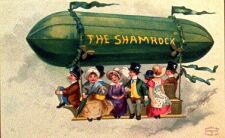The Hoax
"Guarded by a Stranger with a Gun,
a Queer-Looking Machine Is Found in a Western Field."

The Hoax
"Guarded by a Stranger with a Gun,
a Queer-Looking Machine Is Found in a Western Field."

The above headline ran in the New York World newspaper on April 17, 1897. The queer-looking machine was a mysterious airship that was found on the banks of the Cedar River in Waterloo. The aircraft was about 40 feet long, shaped like a giant cigar, with wing-like attachments on the sides and a steering apparatus in the rear. It had a cupola with a lookout chair on the roof, was built of canvas, varnished and sported a pipe which constantly emitted a vapor.
On that early Spring morning in 1897, word spread quickly around Waterloo, Iowa that an airship had landed on the circus grounds, just below Fifth Street Bridge. A man said to be a balloonist-explorer-scientist was with the airship, speaking in a strange language, and guarding his ship against sightseers. Earlier that morning police received a phone call from a man identifying himself as Professor Jourgensen. He spoke in broken English and said he was from San Francisco, California, had landed in a balloon, and was afraid the aircraft might be damaged by sightseers. Police quickly arrived on the scene, roped off the aircraft and stood by to guard it.
The Professor furnished the press with a log of his trip. He expounded on how he and his traveling companion, Professor Starmout, had left San Francisco on March 25th, wandered across the country and had even landed in Indian Territory to forge for supplies and repair their ship. Sadly, while adjusting the rudder at 3:47 a.m., April 17th (according to the Professor's log), Starmout had fallen overboard into the darkness. The Professor's log showed he landed the airship in Waterloo a few minutes later, at 3:59 a.m. He gallantly offered a $500 reward for the recovered remains of his partner and a search party from Vinton set out along the river to look for Starmout's body.
Requests for information on the airship came from across the nation and even from across the oceans. Passenger trains made unscheduled stops to allow passengers to view the mystery ship. Groups from as far away as Webster City came for a look. However, Professor Jourgensen would not allow anyone to look inside because he didn't want his secret engine revealed. (The secret was that there was no engine, the interior was empty!)
About the second night, Mrs. Casebeer (Jack Casebeer's mother) came home after viewing the ship and noticed that paint on her son's coat matched that of the airship. She immediately became suspicious. When J.O. Baker went to view the airship, he recognized Professor Jourgensen as Elias Feather of Nashua, Iowa, a neighbor of Mr. Baker's parents. The hoax quickly fell apart, but no harm was done and everyone seemed to agree they had a good time, including those who had been fooled.
News reports from all over the country of mysterious night-flying aircraft had prompted the elaborate prank as some Waterloo men decided to make the rumors come true. Fred Kimball, Jack Casebeer, Thomas Cascaden, and many others reportedly had a hand in the hoax. Kimball supplied the idea, Cascaden supplied the warehouse for building the aircraft, and Casebeer donated some old canvas and paint. These men and others worked nights for a week on the airship. The center of the ship had an old Illinois Central engine headlight mounted on a board.
Under cover of darkness, several policemen (including Charles Wetlaufer) helped the men carry the airship to the banks of the Cedar River, at the old circus grounds (later site of the Herrick Refrigerator Co.) Among those given credit for the hoax was Harry E. Kiester, a Courier evening reporter. Many more (including some prominent businessmen who preferred to remain anonymous) contributed indirectly to the hoax with money, ideas, or work.
...by M. B. Eldridge
Contributed to IAGenWeb Project, Black Hawk County, March 10, 1999